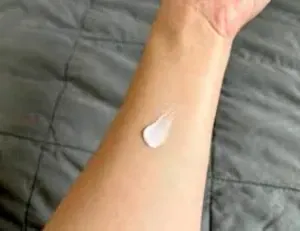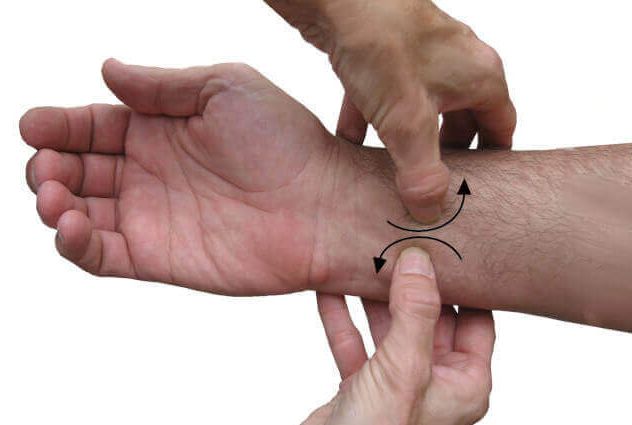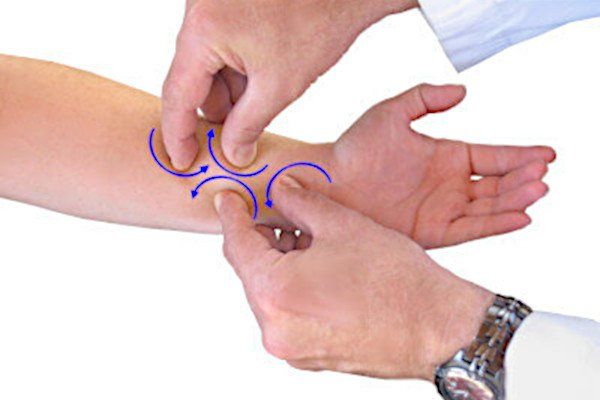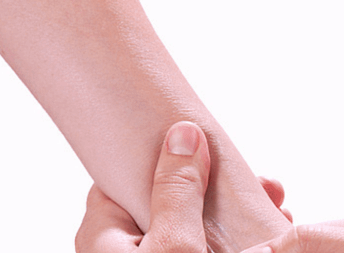Since you'll be rubbing skin, it's god practice to apply a hypoallergenic skin lotion for lubrication. Apply it to the palm surface of the forearm, from the wrist crease to about one-third of the way up the arm.
How to Perform Myofascial Release for Carpal Tunnel
From Dr. Z - Carpal tunnel syndrome specialist
What is Myofascial Release for Carpal Tunnel?
A specific type of massage, called myofascial release, can be an effective treatment for carpal tunnel syndrome. The technique relaxes tendons in the wrist, loosens restrictions, and reduces pressure on the median nerve. By doing so, hand pain, numbness, tingling, and burning are relieved. Grip strength, range of motion, and hand function can also improve.
Myofascial release involves the kneading of tissues to break up adhesions (stuck-together tissues) in the wrist and forearm. "Myo" refers to muscles, while "fascial" refers to the membranes surrounding muscles (called fascia).
Myofascial release for carpal tunnel involves specific finger movements. Learn how to perform this powerful therapy below.
- Think you have carpal tunnel? Complimentary self-test
- Already know you have carpal tunnel? This Quiz tells you its severity
Why is myofascial release important?
Myofascial release of the wrist and forearm is a therapist's "first line" of defense to eliminate carpal tunnel symptoms. The reason that it's so effective is because it attacks the source of the disorder; flexor tendon inflammation and swelling.
People who use their hands vigorously or engage in harmful hand activities are prone to tendon problems, like tissue adhesions and restrictions. These adhesions cause tendon inflammation and swelling. When the swelling occurs inside your wrist joint, it compresses the adjacent median nerve. This compression is what produces the characteristic signs of carpal tunnel syndrome.
The signs and symptoms of carpal tunnel syndrome include:
- Pain
- Numbness
- Tingling
- Shooting electric shocks
- Burning
- Weakness
- Loss or dexterity
- Clumsiness
- Itching
Myofascial release massage breaks-up adhesions and restrictions inside your wrist joint. As a result, inflammation diminishes. Then the pain, numbness, weakness (and other symptoms of carpal tunnel) disappear - usually for good.
It’s not just for carpal tunnel
How else can you use myofascial release? For carpal tunnel, it works great. But that's not its only application. Here’s a short list of other debilitating conditions myofascial release massage is effective in resolving:
- Fibromyalgia
- Tendonitis
- Back pain
- Osteoarthritis
- Plantar fasciitis
- Scars (hypertrophic, hypersensitive, painful scars, burn scars, mastectomy scars)
- Tennis elbow
- Chronic pain

Tips to perform myofascial release for carpal tunnel
Use proper technique
- Like most physically related therapies, it's important to perform myofascial release massage for carpal tunnel properly. It's not advisable to do the massage yourself. That's because you need at least two fingers (2 thumbs with or without 2 forefingers) to perform the massage. Recruit a willing partner (or a therapist) for best results. Alternatively, you can use the CarpalRx which is designed to perform myofascial release massage automatically.
Create a daily regimen
- Establishing (and sticking to) a daily regimen for your therapy is key. Myofascial release massage for carpal tunnel must be performed twice daily for 15 minutes, and for at least 30 days. It's best to do it first thing in the morning and last thing in the evening.
Be patient
- Reversing carpal tunnel syndrome is not an overnight process. It took years of accumulated stresses for the disorder to finally appear. And it takes time for it to disappear. So be patient. Nothing cures carpal tunnel overnight (even surgery takes weeks).
Do not...
- Do not perform myofascial release on yourself. It just won’t work because you need at least two fingers to knead the skin and underlying tissues.
- Do not skip your twice-daily sessions of massage. Be consistent and persistent, or else you’re just wasting time.
- Do not use a vibration massager to treat your carpal tunnel syndrome. In fact, vibrating tool use is one of the causes of carpal tunnel syndrome. Vibrating tools also cause vibration syndrome.
How to perform myofascial release for carpal tunnel
1. Apply skin lotion
2. Position yourself properly
3. Counter-rotating fingers
4. Massage entire lower forearm
5. Two 15 minutes sessions daily
6. Use the right amount of massage pressure
The results
Most therapists agree that carpal tunnel massage using myofascial release works quite well to eliminate carpal tunnel syndrome. Symptoms like pain, numbness, tingling, shooting electric shocks, burning, weakness, and clumsiness often disappear for good.
Note that symptoms will not disappear overnight. That's because, for most patients, tendon tissue healing takes time. Thus, symptoms resolution is very gradual. That means the patient will not see daily decreases in symptoms. But they should notice decreases from one week to the next. Again, patience and persistence are the keys.
Conclusion
Myofascial release for carpal tunnel syndrome is the "first line" treatment of therapists. Why? Because this remedy goes to the source of the problem: it breaks up adhesions and loosens restrictions around the flexor tendons. This, in turn, permanently reduces tendon inflammation and swelling. As a result, pressure is relieved from the median nerve, relieving the unpleasant symptoms of carpal tunnel. No surgery is ever required. But the massage technique is very specific, and must be performed every day to ensure good results.








